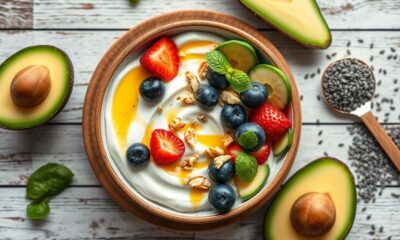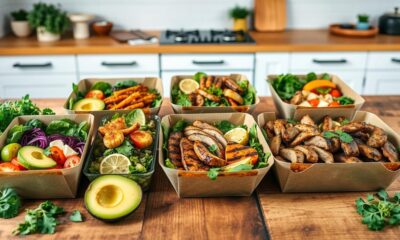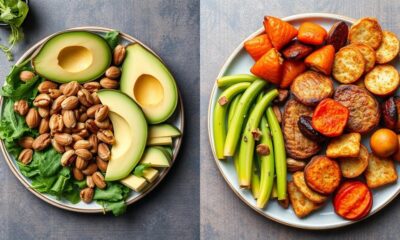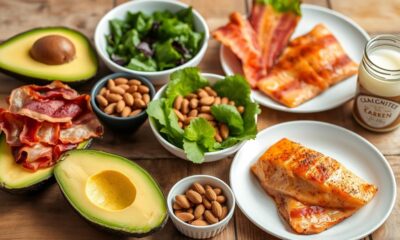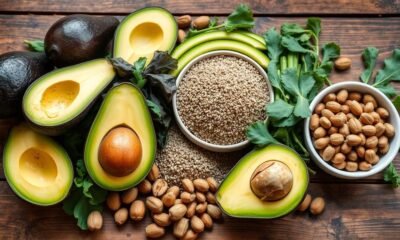FAQs
Best Restaurants to Eat at While on Keto Diet
Keto dining made easy: discover the best restaurants that cater to your low-carb lifestyle and unlock delicious options you didn’t know existed!

Finding keto-friendly restaurants is easier than ever. For quick bites, try Jimmy John's for their lettuce-wrapped Unwich or Chipotle's Keto Salad Bowl. If you're dining out casually, Chili's Classic Sirloin or Applebee's Chicken Breast Patty will keep your carbs low. Always customize your meals; opt for grilled proteins and pair them with non-starchy veggies. Don't forget to ask for extra healthy fats like avocado or olive oil. Keep an eye out for hidden carbs in dressings and sauces. Curious about more options or tips? There's plenty more to explore to make your keto dining seamless! If you’re looking to enhance your keto experience, consider supplementing with the best keto diet pills to support your weight loss and energy levels. With a little planning and research, you can easily find keto-friendly options at a variety of restaurants to keep you on track with your low-carb lifestyle. And don’t be afraid to get creative and ask for substitutions or modifications to make any menu item fit your keto needs.
Key Takeaways
- Fast Food Chains: Choose low-carb options like Jimmy John's Unwich or Wendy's Parmesan Caesar Salad for quick keto-friendly meals.
- Casual Dining: Restaurants like Chili's and TGI Fridays offer hearty meals like sirloin and Cobb salads with low net carbs.
- Meal Customization: Opt for grilled proteins with non-starchy veggies, and request sauces on the side to control carb intake.
- Healthy Fats: Enhance dishes by adding olive oil, avocado, or extra cheese to boost healthy fat content while keeping carbs low.
- Monitor Hidden Carbs: Be cautious of sauces and dressings that may contain added sugars, and always check nutrition information before ordering.
Understanding Keto Diet Basics
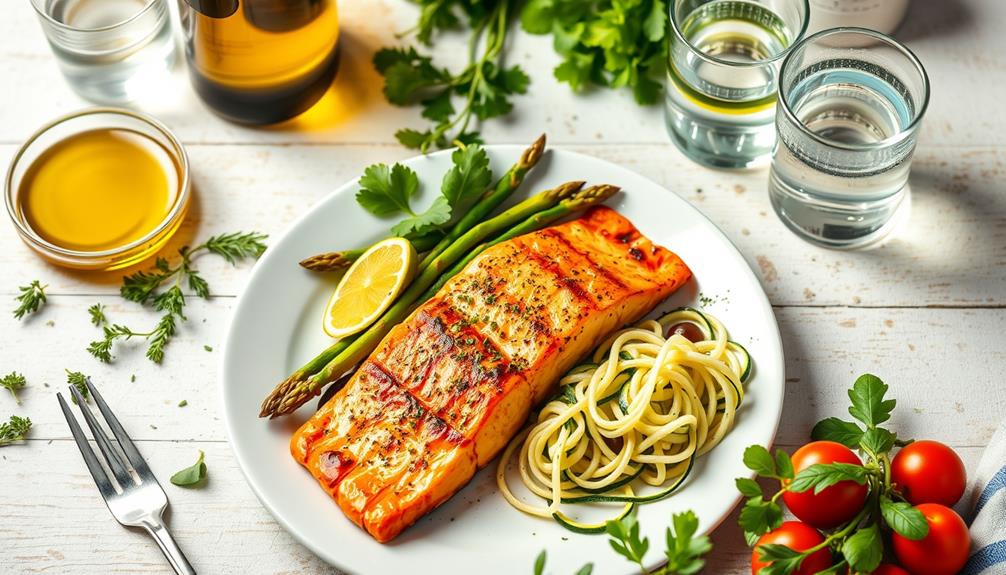
Understanding the basics of the keto diet can greatly impact your health journey. This high-fat diet emphasizes a macronutrient ratio of 70-80% fats, 10-20% protein, and only 5-10% low in carbs. The goal is to enter ketosis, where your body burns fat for fuel instead of carbohydrates.
To effectively follow the keto diet, you'll need to monitor net carbs, which you calculate by subtracting fiber and sugar alcohols from total carbohydrates. This helps you manage blood sugar levels while ensuring you remain in ketosis. It's also imperative to be aware of common financial terms related to health investments, as following a specialized diet can sometimes affect your budget.
Customization of meals is essential, especially when dining out. Opt for dishes that include healthy fats and fiber-rich vegetables to keep you satisfied and support digestive health.
Various keto diet variations exist, such as medical keto or modified Atkins, each tailored with specific macronutrient ratios and restrictions. By focusing on whole, nutritious foods and being mindful of hidden sugars and high-carb ingredients, you can adapt your meals to fit your goals.
Whether you're aiming for weight loss or simply seeking a healthier lifestyle, understanding the keto diet basics will set you on the right path.
Top Keto-Friendly Chain Restaurants
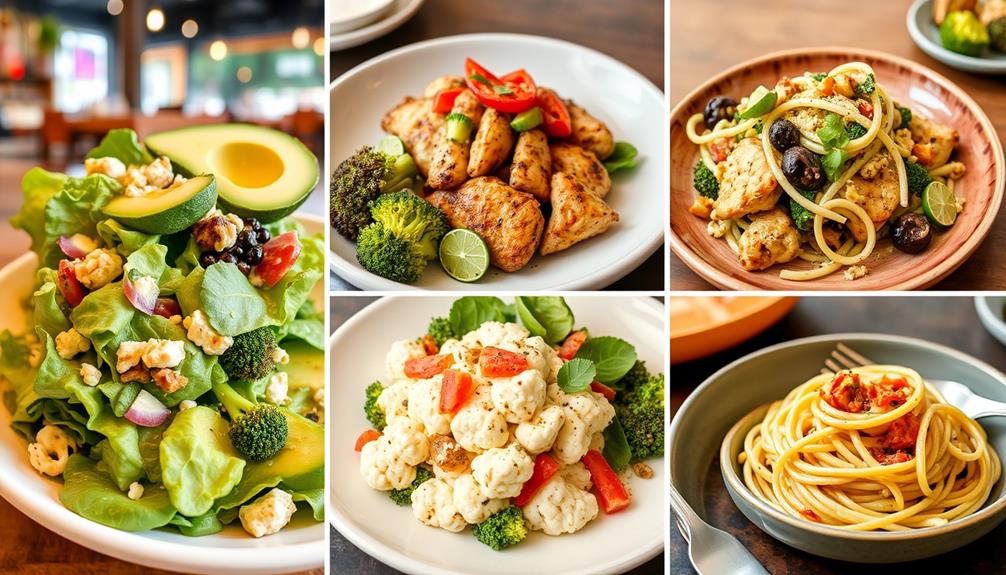
When you're out and about, finding keto-friendly options at chain restaurants can be a game-changer.
Many places now offer meals that fit your low-carb lifestyle without sacrificing flavor, and incorporating essential oils for wellness can enhance your dining experience.
Let's explore some top picks that keep you on track while satisfying your cravings.
Fast Food Options
Finding keto-friendly options at fast food restaurants has never been easier, thanks to a growing number of chains that cater to low-carb diets. You can enjoy tasty meals without exceeding your carb limit with these delicious keto options.
Here are some top picks from popular fast food chains:
| Restaurant | Menu Item | Net Carbs |
|---|---|---|
| Jimmy John's | Unwich (lettuce-wrapped) | 10 grams |
| Chipotle | Keto Salad Bowl | 7 grams |
| Wendy's | Parmesan Caesar Salad | 4 grams |
| In-N-Out | Protein Style Burger | 8 grams |
At Jimmy John's, their Unwiches are perfect for on-the-go meals, while Chipotle's customizable Keto Salad Bowl packs a flavorful punch with chicken, salsa, and guacamole. Wendy's bunless burgers and the Parmesan Caesar Salad offer great protein options with minimal carbs. In-N-Out's Protein Style burger lets you indulge in a juicy burger without the bun, keeping it keto-friendly.
With these choices, you can satisfy your cravings while sticking to your keto diet. Enjoy your fast food guilt-free!
Casual Dining Choices
If you're looking for casual dining options that fit your keto lifestyle, you're in luck. Many chain restaurants now offer keto-friendly meals that keep your net carbs low while satisfying your cravings.
Additionally, understanding how different cooking methods can affect the nutritional content of your meals is essential, especially if you're mindful of your health brewing methods affect caffeine content.
At Chili's, you can enjoy the Classic Sirloin with Grilled Avocado and Steamed Broccoli, which clocks in at 400 calories, 18g fat, and just 10 grams net carbs.
Applebee's serves a Chicken Breast Patty with Garlicky Green Beans, providing only 5 grams net carbs and 340 calories—perfect for a low-carb meal.
For a light yet tasty option, try the Small Caesar Salad (without croutons) at the Cheesecake Factory, offering 440 calories, 38g fat, and only 11 grams net carbs.
If you're feeling hearty, TGI Fridays' Million Dollar Cobb Salad with grilled chicken has 1,000 calories, 75g fat, and 12 grams net carbs.
Meal Customization Strategies
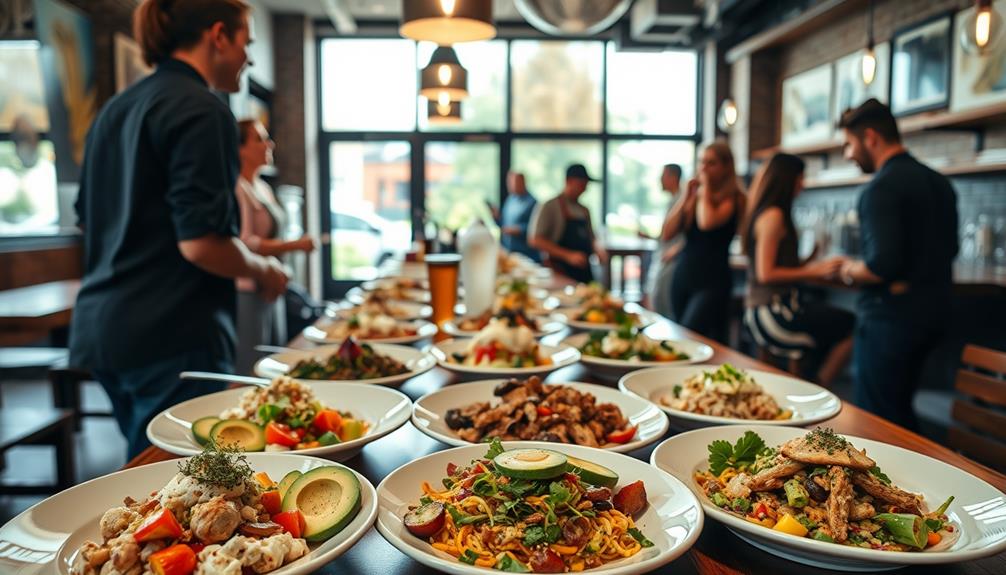
When you're dining out, choosing grilled proteins is a smart move to keep your meal low in carbs.
Additionally, exploring various coffee varieties can enhance your dining experience, offering unique flavor profiles that can complement your meal.
Don't hesitate to ask for extra healthy fats like avocado or cheese to boost flavor and satisfaction.
Opt for Grilled Proteins
Opting for grilled proteins is a smart way to stay on track with your keto diet while dining out. When you choose grilled chicken, grilled salmon, or lean cuts of steak, you minimize carbs and maximize your protein intake. Make sure to request modifications, like having your proteins grilled instead of fried, which can add unnecessary carbs and unhealthy fats.
Pair your grilled proteins with non-starchy vegetables to enhance nutrient intake while keeping your carb counts low. When choosing your meal, don't forget to ask for sauces on the side. This allows you to control portions and avoid hidden sugars that can derail your high-fat diet.
Here's a quick reference for your grilled protein choices:
| Protein Type | Keto Benefits |
|---|---|
| Grilled Chicken | High in protein, low in carbs |
| Grilled Salmon | Rich in healthy fats, provides omega-3s |
| Lean Cuts of Meat | Higher protein content with lower fat |
| Non-Starchy Veggies | Enhance nutrition while keeping carbs minimal |
Choose Low-Carb Toppings
At restaurants, choosing low-carb toppings can make a substantial difference in keeping your meal keto-friendly. Start by opting for grilled chicken or other grilled proteins instead of breaded or fried options. This not only reduces carbs but also boosts the protein content of your meal.
Additionally, being aware of common types of cold medications can help you make informed choices if you're feeling under the weather while dining out.
When ordering salads, skip the croutons and starchy veggies. Instead, load up on leafy greens, avocado, and full-fat cheese to create a satisfying salad without compromising your keto goals. You can also enhance your meal with healthy fats by adding nuts or seeds, which provide both flavor and nutrition.
Be mindful of sauces and dressings, as many contain hidden sugars. Stick with low-carb options like olive oil, vinegar, or creamy dressings without added sugars to keep your keto meal compliant.
If you're craving pizza, customize it with a cauliflower crust or zucchini noodles instead of traditional dough. This simple swap can substantially lower your carb intake while still allowing you to enjoy your favorite dishes.
Request Extra Healthy Fats
How can you make your meals even more satisfying on a keto diet? It's simple: request extra healthy fats! This not only elevates flavor but also aligns perfectly with your keto goals by keeping the grams of net carbs low.
Here are some easy strategies to customize your meals:
| Customization Options | Benefits |
|---|---|
| Request extra olive oil | Boosts healthy fat content in salads |
| Add avocado slices | Adds creaminess with minimal carbs |
| Choose cream-based sauces | Higher fat, fewer carbs than vinaigrettes |
| Ask for proteins cooked in extra oil | Richness that enhances taste |
When ordering grilled chicken or fish, don't hesitate to ask for them cooked in extra oil or butter. You can also customize your protein dishes by adding additional cheese, like mozzarella or feta, to amp up the flavor and fat content. These tweaks can transform your meal into a keto-friendly delight that satisfies your cravings while keeping you on track. So, next time you're out, remember to request those extra healthy fats!
Hidden Carbs to Watch For

Often, diners underestimate the hidden carbs lurking in restaurant dishes, which can derail your keto diet. You might be surprised to find that sauces and dressings often contain added sugars, greatly increasing the total carb count.
To stay on track, always ask about preparation methods and opt for grilled options whenever possible. Additionally, it's wise to reflect on investment strategies that diversify your food choices, similar to how one would diversify a retirement portfolio with gold IRAs.
While many vegetables are healthy, starchy vegetables like carrots and peas can be high in carbs, so it's best to limit or avoid them.
Additionally, items labeled as "low-carb" can still hide considerable carbs, so scrutinizing ingredient lists is essential.
Watch out for sugar alcohols like erythritol and xylitol, which may not be included in the nutrition information, leading to underestimating your total carb intake. Always check with restaurant staff for specifics on these ingredients.
Nutritional Considerations While Dining

Dining out on a keto diet requires careful planning to guarantee you stick to your nutritional goals. To maintain ketosis, aim to keep your net carbs under 20 grams per day. Focus on high-protein and high-fat meals, and don't be afraid to customize your dishes to align with your dietary needs. Incorporating antioxidant-rich foods can also enhance your meal's nutritional value without compromising your carb limit.
Here are some key considerations to keep in mind:
- Choose grilled chicken or other high-quality proteins.
- Opt for non-starchy vegetables like broccoli, spinach, or zucchini as sides.
- Always ask for dressings on the side to avoid hidden sugars.
- Prioritize whole foods over breaded or fried options.
When you're at a restaurant, consider requesting substitutions, such as lettuce wraps instead of buns or zoodles instead of pasta. This way, you can enjoy your meal without compromising your high-fat diet like keto.
Remember to be vigilant about sauces and dressings, as they can often contain hidden sugars that derail your efforts. By focusing on these nutritional considerations, you'll be able to enjoy dining out while staying true to your keto lifestyle.
Tips for Eating Out on Keto

When you're maneuvering the menu at a restaurant, keeping your keto goals in mind can make a significant difference in your dining experience. Start by prioritizing low-carb options like bunless burgers, grilled proteins, and fresh salads. These choices help keep your carb intake in check while satisfying your hunger.
Additionally, incorporating techniques such as yoga for back pain can enhance your overall wellness as you enjoy your meals.
Don't forget to enhance your meals with healthy fats. Drizzle olive oil on your salads, add avocado slices, or sprinkle cheese over your dishes for that extra flavor and nutrition. Always be cautious of hidden sugars and carbs lurking in dressings and sauces, as they can derail your keto progress.
Feel free to customize meals to fit your needs. Opt for grilled proteins instead of breaded options, and swap out bread for lettuce wraps or a side salad. This not only aligns with your keto diet but also adds freshness to your meal.
Before heading out, use restaurant apps or websites to access nutrition information. This allows you to make informed decisions and stick to your keto guidelines without any surprises.
Enjoy dining out while staying committed to your health goals!
Frequently Asked Questions
What Foods Can I Eat Unlimited on Keto?
On a keto diet, you can enjoy unlimited non-starchy vegetables like spinach and kale, healthy fats such as avocados and olive oil, and moderate amounts of cheese and full-fat dairy products. Enjoy your meals!
Who Has Keto-Friendly Meals?
When you're craving delicious meals without the guilt, several places have got you covered. Chains like Chipotle, Chili's, and Panera serve options you can easily customize, ensuring you enjoy satisfying, low-carb dishes anytime.
Is Chinese Food Allowed on Keto?
Chinese food can be tricky on keto, but you can enjoy it. Focus on protein-rich options like steamed meats and stir-fried veggies, and ask for no sauces or rice to keep carbs low.
What Junk Food Is Keto Friendly?
You can enjoy keto-friendly junk food like bunless burgers, plain wings, and lettuce-wrapped sandwiches. Fast food chains often offer low-carb options, so you can satisfy cravings without breaking your diet. Just customize wisely!
Conclusion
To summarize, sticking to your keto diet while dining out doesn't have to be a challenge. With a little planning and knowledge, you can enjoy delicious meals without compromising your goals. So, next time you're at a restaurant, why not savor a juicy steak with a side of greens instead of the usual carbs? Embracing these options can make your dining experience both satisfying and keto-friendly. Enjoy your meals while staying true to your lifestyle!
FAQs
Best Alcohol to Drink on Keto Diet
Stay within your carb limits while enjoying the best alcohol on a keto diet—discover the surprising options that won’t derail your progress!
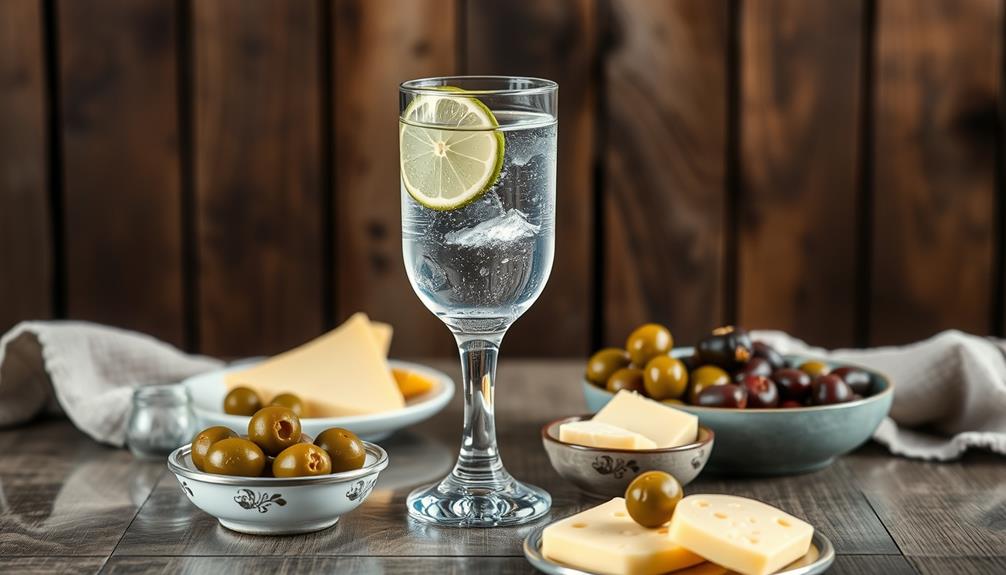
On a keto diet, you can enjoy alcohol without compromising your carb limits. Stick to plain spirits like vodka, gin, tequila, rum, and whiskey, as they contain zero carbs. Dry wines, both red and white, have around 2 to 6 grams of carbs per 5-ounce serving. For a bubbly option, choose brut champagne or prosecco, which have less than 1 gram of carbs per ounce. Light beers like Michelob Ultra are also good choices. Just remember to avoid sugary mixers and high-carb cocktails to stay on track. There's plenty more to discover about keto-friendly drinking options.
Key Takeaways
- Plain spirits like vodka, gin, tequila, rum, and whiskey contain zero carbs, making them ideal for the keto diet.
- Dry wines, both red and white, have 2 to 6 grams of carbs per 5-ounce serving, suitable for moderation.
- Brut Champagne and Prosecco offer less than 1 gram of carbs per ounce, providing a sparkling option for keto dieters.
- Light beers like Michelob Ultra and Corona Premier contain 2 to 3 grams of carbs per 12-ounce serving, making them a low-carb choice.
- Use low-carb mixers such as soda water, diet tonic, or diet cola to keep cocktails keto-friendly and limit carb intake.
Overview of the Keto Diet

The keto diet is a popular eating plan that flips traditional dietary norms on their head. It emphasizes a high-fat, low-carbohydrate approach, aiming to shift your body into a state of ketosis. In ketosis, your body burns fat for fuel instead of carbohydrates, which can lead to effective weight loss and improved metabolic health.
You typically restrict your carbohydrate intake to less than 50 grams per day, focusing on low-carb options like meat, fish, eggs, nuts, seeds, avocados, and non-starchy vegetables. Investing in precious metals can be a strategic way to diversify your financial portfolio, similar to how the keto diet diversifies your nutrient intake.
While you're enjoying the benefits of the keto diet, it's crucial to reflect on how alcohol consumption fits into your plan. Alcohol can interfere with your weight loss goals because your body prioritizes metabolizing alcohol over burning fat. This can temporarily halt fat burning and even increase your appetite.
To maintain ketosis, you need to pay attention to the carb content of alcoholic beverages. Opting for low-carb options, such as spirits, dry wines, and light beers, can help you navigate your social life without derailing your progress. Understanding these elements can keep you on track while enjoying the flexibility of the keto diet.
Keto-Friendly Alcoholic Options

Finding keto-friendly alcoholic options doesn't have to be complicated. When you're following a keto diet, you can still enjoy drinks without worrying too much about your carb intake.
It's important to remember that moderation is key, and staying hydrated with low-carb beverages can also support your overall health. Start with plain spirits like vodka, gin, tequila, rum, and whiskey, which contain zero carbs per serving. These make excellent keto-friendly alcoholic beverages.
Gastrointestinal issues can arise with certain drinks, so be mindful of your choices.
If you prefer wine, go for dry varieties. Red and white wines typically have around 2 to 6 grams of carbs per 5-ounce serving—Cabernet Sauvignon, for example, has about 3.8 grams.
For sparkling options, brut Champagne and Prosecco are fantastic choices, boasting less than 1 gram of carbs per ounce.
If beer's more your style, opt for light beers like Michelob Ultra or Corona Premier, which contain around 2 to 3 grams of carbs per 12-ounce serving.
Just remember, when mixing drinks, stick to low-carb mixers such as soda water or diet tonic. These options keep your drink keto-friendly while minimizing carbs per serving.
Low Carb Mixers to Consider

When you're mixing drinks on a keto diet, choosing the right low-carb mixers can make all the difference. Options like diet cola, seltzer, and diet ginger ale keep your cocktails flavorful without blowing your carb count.
Additionally, exploring various coffee varieties can introduce unique flavors to your drinks. By opting for these ideal mixers, you can enjoy invigorating beverages while sticking to your diet goals.
Ideal Low-Carb Options
Mixing your favorite spirits with low-carb options can keep your keto diet on track while still enjoying a night out. Choosing the right mixers is essential for maintaining your carbohydrate limit, so here are some ideal selections to evaluate.
| Mixer | Carbs (per serving) | Best Spirit Pairing |
|---|---|---|
| Diet Soda | 1.04g (12 oz) | Rum or Vodka |
| Sugar-Free Tonic Water | 0g | Gin |
| Soda Water | 0g | Vodka (with lemon/lime) |
| Crystal Light (packet) | 1.75g | Any spirit for flavor |
These low-carb options allow you to enjoy your favorite alcohol choices without jeopardizing your ketogenic diet. For a revitalizing twist, evaluate mixing vodka with soda water and a splash of lemon or lime, keeping it completely carb-free. Alternatively, sugar-free tonic water can add flavor to your gin and tonic without the carbs. Just be sure to avoid high-carb mixers like regular soda or fruit juices, which can quickly derail your progress by adding substantial carbohydrates. Stick to these low-carb mixers, and you'll enjoy a guilt-free night out!
Cocktail Enhancements for Keto
Enhancing your cocktails while sticking to a keto diet is easier than you might think. When it comes to keto-friendly drinks, choosing the right low carb mixers is key. Opt for plain soda water, diet tonic water, or diet cola, as these options contain minimal to zero grams of carbs, making them perfect for your cocktails.
Additionally, being mindful of your budget and tracking your expenses while enjoying these drinks can help maintain financial health, especially if you're looking to manage costs associated with your lifestyle choices financial health tips.
For a revitalizing yet low-carb drink, mix vodka with soda water and add a splash of lemon or lime. This combination keeps your cocktail carb-free while boosting its flavor. You can also use flavored sparkling water, which often has 0 grams of sugar and carbs, to elevate your drink without compromising your diet.
Another great option is powdered drink mixes like Crystal Light. With only 1.75 grams of carbs per packet, they can add flavor to your cocktails without derailing your keto goals.
Just remember to avoid regular sodas and juices, as they can dramatically increase the carb content—regular soda alone packs about 39 grams of carbs per 12 oz serving. Stick to these low carb mixers, and you'll enjoy delicious cocktails that align with your keto lifestyle.
High Carb Drinks to Avoid

Many popular alcoholic beverages are packed with carbs, making them detrimental to your keto diet. When you're watching your carb intake, it's vital to identify high carb drinks to avoid. Cocktails are a major culprit; they often exceed 30 grams of carbs per serving due to sugary mixers.
For example, a whiskey sour contains about 14.49 grams of carbs, while a margarita has around 19.32 grams. Even more concerning are piña coladas, which can pack a staggering 25.35 grams in just one serving.
Additionally, some essential oils, such as eucalyptus oil, can help support respiratory health, making it easier to enjoy social gatherings without feeling congested.
Sweet wines, including dessert wines and sweet reds, can also complicate your carb management, as they typically contain more than 5 grams of carbs per serving.
Additionally, mixed drinks made with regular soda or fruit juices should be avoided, as these high-carb mixers can quickly increase your overall carbohydrate intake.
To stay on track with your keto goals, steer clear of these high carb drinks. Instead, focus on low-carb alcohol options that will help you maintain ketosis without sacrificing enjoyment.
Alcohol's Impact on Health
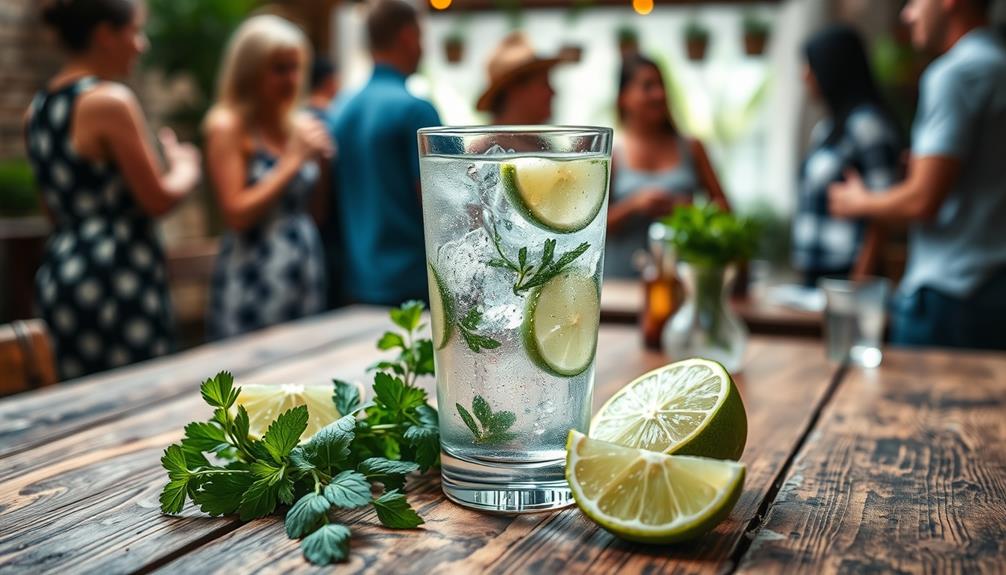
When you're on a keto diet, alcohol can complicate your weight loss goals.
It not only adds empty calories but can also trigger cravings and hinder fat burning.
To maintain nutritional balance, moderation is key to enjoying alcohol without derailing your progress.
Alcohol and Weight Gain
Alcohol can greatly impact your weight loss journey, primarily because your body prioritizes metabolizing it over burning fat. When you consume alcohol, especially in excess, your body shifts its focus to processing it, which can stall ketosis and lead to weight gain.
Studies show that more than two drinks per day can increase body weight and contribute to that unwanted "beer belly," largely due to the high calorie content in many alcoholic beverages.
Moreover, alcohol provides empty calories, lacking essential nutrients. This can create nutritional deficiencies that complicate your weight management efforts. It's essential to be mindful of your alcohol intake, especially since some drinks can contain over 30 grams of carbs and sugar per serving. Such high-carb options can throw you off your keto game, making it harder to maintain ketosis.
Even low-carb alcoholic beverages can trigger increased hunger and cravings, which might lead to overeating. Balancing your alcohol choices with your overall dietary goals is key to avoiding unwanted weight gain.
Moderation and Nutritional Balance
Finding the right balance between enjoying a drink and maintaining your health is essential on a keto diet. You should aim for moderate drinking, which means limiting yourself to one drink per day if you're a woman, and two if you're a man. This helps prevent weight gain and nutritional deficiencies that can arise from excessive alcohol consumption.
Remember, alcohol provides empty calories—these calories lack essential nutrients and can hinder your overall health, especially if you indulge too often.
When you consume alcohol, your body prioritizes its metabolism over fat burning, which can disrupt ketosis and lead to increased hunger and cravings. To stay on track, be mindful of your carb intake from alcoholic beverages, as this is vital for maintaining ketosis effectively.
Additionally, dehydration is another concern; alcohol can contribute to it, so make sure to stay hydrated while drinking.
Recommended Keto Alcoholic Drinks

Maneuvering the world of drinks on a keto diet can be tricky, but there are plenty of options that won't derail your carb goals. You can enjoy a variety of alcoholic beverages while keeping your carb count low. Here are some recommended choices:
| Drink Type | Carbs per Serving |
|---|---|
| Plain Spirits | 0g (vodka, gin, tequila, rum, whiskey) |
| Dry Wines | 2-6g (Cabernet Sauvignon: 5.70g, Sauvignon Blanc: 3.92g) |
| Champagne | 2g (Brut champagne/prosecco per 5 oz) |
| Low-Carb Beers | 2.6g (Michelob Ultra per 12 oz) |
When indulging, opt for plain spirits like vodka or gin, which contain zero carbs. Dry wines, particularly reds and whites, can fit into your diet nicely with minimal carbs. If you're in the mood for something bubbly, go for brut champagne or prosecco for a festive touch. Pair your spirits with low-carb mixers like diet soda or sugar-free tonic to keep your cocktails keto-friendly. Enjoy your drinks without guilt while sticking to your keto goals!
Tips for Drinking on Keto
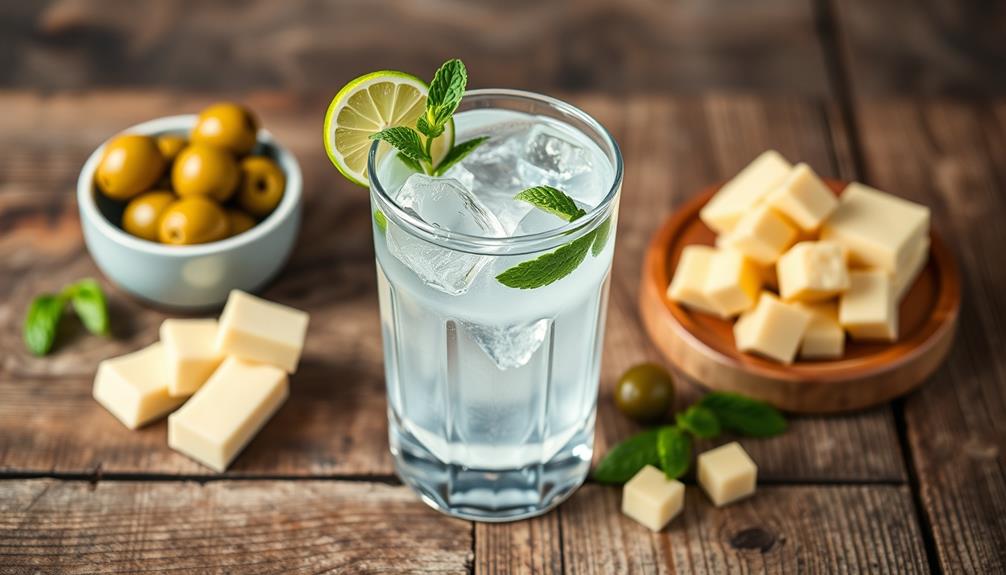
Enjoying a night out or a casual drink at home while on a keto diet doesn't have to be complicated. To stick to your low-carb lifestyle, limit yourself to one drink per day if you're a woman and two if you're a man. This helps maintain ketosis and keeps your calorie intake in check.
When choosing drinks, opt for low-carb options like spirits—vodka, gin, and whiskey typically contain 0-3 grams of carbs per serving. Dry wines are also smart choices.
Avoid regular mixers, as they can greatly increase carb content. Instead, go for low-carb mixers like soda water or diet tonic.
Don't forget to stay hydrated! Drinking water alongside your alcoholic beverages will help mitigate dehydration and support your overall health.
As you navigate your evening, keep an eye on your overall daily carb intake to make sure you stay under the 50 grams typical for a keto diet. With these tips in mind, you'll not only enjoy your drinks but also make the best choices for your keto goals while avoiding the 5 worst pitfalls of alcohol consumption on a diet.
Effects of Keto on Alcohol Tolerance

Going through a keto diet can considerably change how your body processes alcohol, often leading to a reduced tolerance. Many individuals on a ketogenic (keto) diet report that they feel the effects of alcohol more intensely. This shift happens because ketosis alters your metabolism, causing quicker absorption of alcohol. As a result, you might find yourself feeling tipsy after just one drink.
Here are a few key points to keep in mind:
- Hangovers can be worse: Anecdotal evidence suggests that those on keto may experience more severe hangovers, likely due to lower glycogen stores and dehydration.
- Blood sugar fluctuations: Alcohol can temporarily lower your blood sugar, which may trigger increased appetite and cravings, complicating your keto goals.
- Moderation is important: With your altered response to alcohol, it's vital to monitor your intake closely and drink in moderation.
As you navigate your keto journey, be mindful of these effects on your alcohol tolerance. Staying informed and cautious can help you enjoy social situations without derailing your diet.
Resources for Keto Dieters

Often, keto dieters seek reliable resources to help them stay on track and make informed choices. You'll find that extensive guides on keto foods, meal plans, and alcohol choices can greatly support your low-carb lifestyle.
One standout resource is the "Keto Alcohol Guide," which offers a detailed analysis of the best and worst alcoholic drinks for maintaining ketosis while enjoying social events.
If you're new to the keto diet, "Keto Diet for Beginners" provides foundational knowledge, making it easier for you to navigate your dietary choices. It's an excellent starting point for understanding how to incorporate the best options into your routine.
Additionally, the "14-Day Meal Plan" includes structured recipes and shopping lists tailored for keto dieters, ensuring you maintain balanced nutrition while keeping carbs low.
Educational articles from reputable sources like Everyday Health and Healthline will also provide valuable insights into maintaining your keto goals and understanding the effects of alcohol on your diet.
Frequently Asked Questions
What Alcohol Is Ok on Keto?
When considering what alcohol's okay for you, focus on plain spirits like vodka or gin, dry wines, and light beers. These options keep your carb intake low while still letting you enjoy a drink.
What Alcohol Won't Kick You Out of Ketosis?
To avoid kicking yourself out of ketosis, stick to pure spirits or dry wines. They're low in carbs, letting you enjoy a drink without worrying about disrupting your progress on your keto journey.
Can You Drink Alcohol on Keto and Still Lose Weight?
Imagine traversing a tightrope; you can enjoy a drink, but balance is key. Yes, you can drink alcohol on keto and still lose weight, as long as you choose wisely and monitor your intake.
What Drinks Are Good for Ketosis?
When you're looking for drinks that support ketosis, opt for pure spirits like vodka or gin, dry wines with minimal carbs, and brut champagne. Light beers and low-carb mixers can also keep your choices keto-friendly.
Conclusion
In your keto journey, you can enjoy social moments while staying on track. Choose low-carb options, savor your drinks, and embrace the flavors that fit your lifestyle. Remember, moderation is key, and being mindful of your choices can lead to a fulfilling experience. Celebrate your progress, relish the freedom of your journey, and toast to your success. With the right knowledge, you can enjoy a drink without straying from your goals—cheers to that!
FAQs
Is Keto Diet Good for High Cholesterol
Not all diets are created equal; discover how the keto diet could impact your cholesterol levels and heart health.
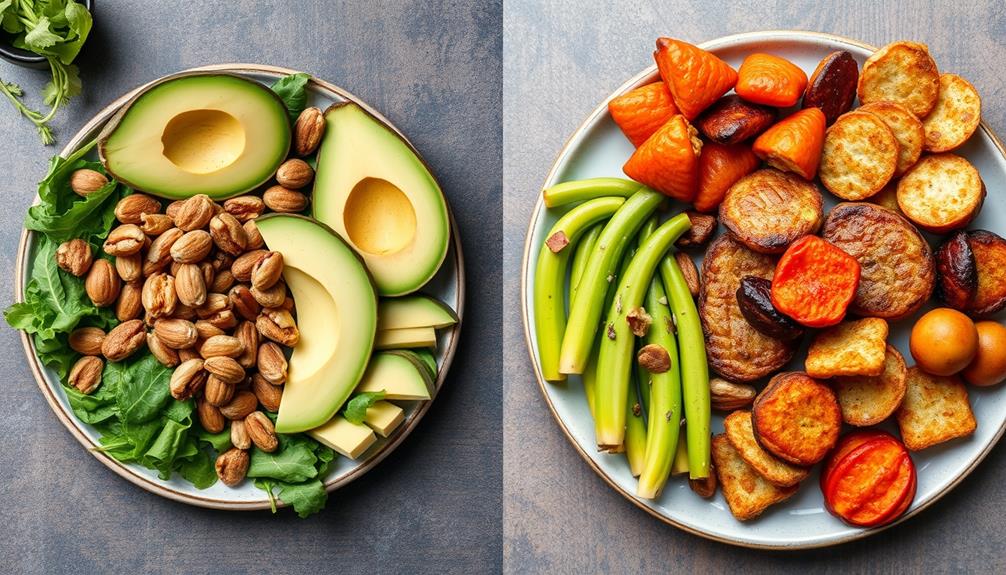
The keto diet can be problematic for those concerned about high cholesterol. You might experience a significant rise in LDL cholesterol, with an average increase of about 245% after one year. While some people see their levels drop after stopping the diet, it's essential to monitor your cholesterol regularly. If you decide to try keto, focus on healthy fats and include fiber-rich foods in your meals. It's also wise to consult a healthcare professional to tailor your approach, especially if you have existing health conditions. There's more to take into account about the long-term effects on your heart health.
Key Takeaways
- The keto diet often leads to a significant increase in LDL cholesterol levels, raising concerns for those with high cholesterol.
- Individuals with familial hypercholesterolemia should avoid the keto diet due to potential health risks.
- Incorporating healthy fats and fiber-rich foods can mitigate negative cholesterol effects on the keto diet.
- Regular monitoring of lipid profiles is essential for anyone on the keto diet, especially those with existing high cholesterol.
- Consultation with healthcare professionals is crucial to tailor dietary adjustments and manage cholesterol effectively on the keto diet.
Overview of the Keto Diet

The keto diet is a low-carb, high-fat approach that can significantly alter how your body processes energy. By drastically reducing carbohydrate intake to about 20-50 grams per day, you push your body into a state known as ketosis. In this state, your body shifts from burning glucose to utilizing fat for energy, which can lead to effective weight loss and improved metabolic health.
Typically, a ketogenic diet consists of 55-75% of your calories coming from fats, 20-30% from protein, and only 5-10% from carbs. This diet can be accompanied by various health considerations, much like the impacts of Cranberry Juice Consumption on overall health.
Originally developed to manage epilepsy in children, the keto diet has gained traction among adults looking to address metabolic disorders like type 2 diabetes. While you may experience short-term effects such as weight loss and better blood sugar control, the strict nature of the diet can make long-term adherence difficult.
Individual responses to the keto diet can vary, so consulting healthcare professionals is essential for personalized guidance. In addition, while the initial results can be promising, ongoing research is needed to fully understand the long-term impact of a high-fat intake on cholesterol, particularly LDL cholesterol levels.
Impact on Cholesterol Levels

Often, individuals on the ketogenic diet see a notable impact on their cholesterol levels, particularly LDL cholesterol. Research shows that after about 12 months on the keto diet, you might experience an average increase in LDL cholesterol of approximately 187 mg/dL, which is roughly a 245% increase. However, if you decide to stop the ketogenic diet, LDL levels may drop considerably, averaging 174 mg/dL—a 220% decrease.
It's vital to note that high meat consumption, especially red meat, can contribute to increased lipid levels. Some individuals, known as "hyper responders," may experience even more pronounced increases in LDL due to genetic factors and a higher ratio of saturated to unsaturated fats. As a result, regular monitoring of cholesterol levels is important, considering the potential health risks associated with high cholesterol.
Here's a summary of the impact:
| Time Frame | LDL Cholesterol | HDL Cholesterol |
|---|---|---|
| Before Keto | Baseline | Baseline |
| After 12 Months | +187 mg/dL | Varies |
| After Cessation | -174 mg/dL | Varies |
| Hyper Responders | Increased | Varies |
| Regular Monitoring | Vital | Vital |
Understanding these changes can help you manage your heart health effectively.
Dietary Adjustments for High Cholesterol

Managing high cholesterol while following a ketogenic diet requires thoughtful dietary adjustments. By making the right choices, you can support your cholesterol management and heart health effectively. Here are three key dietary adjustments to evaluate:
1. Focus on Healthy Fats: Replace saturated fats with heart-healthy monounsaturated fats from sources like avocados and olive oil. Incorporate polyunsaturated fats, especially omega-3 fatty acids found in fatty fish and flax seeds, to improve your lipid profiles.
Additionally, being aware of the potential side effects and interactions of various fats can further guide your dietary choices cold medications overview.
2. Emphasize Fiber-Rich Foods: Include low-carb vegetables, nuts, and seeds in your meals. These foods provide essential fiber that can help lower high cholesterol levels and contribute to overall heart health.
3. Avoid Harmful Options: Stay clear of artificial trans fats, processed meats, and fried foods, as these can worsen high cholesterol levels and increase cardiovascular risks.
Regularly monitoring your lipid profiles and consulting with healthcare professionals can help you tailor these dietary adjustments to fit your specific needs on the keto diet.
Health Considerations and Contraindications

When considering the keto diet, it's important to recognize potential health considerations and contraindications that could impact your well-being. If you have familial hypercholesterolemia, the keto diet mightn't be suitable for you, as it can lead to significant increases in LDL cholesterol levels.
Individuals with kidney or liver disease should also approach this diet cautiously, since it may worsen their conditions. Additionally, those managing insulin resistance may find that the high-fat content of the diet complicates their health management, making it significant to emphasize whole foods and low-glycemic options effective strategies for weight loss.
For those managing type 1 diabetes, the keto diet can complicate your health management due to its effects on insulin levels. Furthermore, if you have any genetic disorders affecting fat metabolism, seeking medical advice is important before starting the keto diet to prevent adverse effects on cholesterol levels.
Pregnant individuals should be particularly cautious; animal studies suggest that the keto diet might negatively impact fetal growth and mental health.
Research Insights and Expert Opinions

Understanding the potential impact of the keto diet on cholesterol levels is vital for anyone considering this dietary approach. Research shows that while the keto diet can offer health benefits, it can also lead to significant changes in LDL cholesterol levels.
For instance, maintaining a balanced budget is essential when considering dietary changes, as it can impact overall financial health. Here are some important insights:
- LDL Cholesterol Increase: Studies indicate that individuals on the keto diet can experience an average increase of 245% in LDL cholesterol after 12 months.
- Impact of Dietary Changes: When participants stopped the keto diet, they saw a 220% decrease in LDL cholesterol, highlighting the diet's influence on cholesterol levels over time.
- Genetic Factors: Genetic factors can play a role in how your body responds to the keto diet, necessitating personalized dietary recommendations.
Experts stress the importance of monitoring cholesterol levels closely when following a ketogenic diet, given the potential for exaggerated cholesterol responses and cardiovascular risk.
Long-term studies are essential to understand the implications of elevated cholesterol in relation to heart health and to evaluate the clinical significance of these changes.
As you navigate the keto diet, stay informed and consult with healthcare professionals for tailored guidance.
Frequently Asked Questions
Is the Keto Diet Safe for Someone With High Cholesterol?
If you have high cholesterol, it's essential to consult your healthcare provider before starting the keto diet. They can help assess your individual risks and guide you on maintaining a heart-healthy approach while dieting.
What Is the Best Diet for Someone With High Cholesterol?
Did you know that a Mediterranean diet can reduce heart disease risk by up to 30%? Focus on unsaturated fats, fiber-rich foods, and omega-3s. Consult your doctor to tailor a heart-healthy plan that suits you.
Is a Low-Carb Diet Good for High Cholesterol?
A low-carb diet can impact cholesterol levels differently for you. While LDL might rise initially, HDL often increases. It's essential to monitor your cholesterol and choose healthy fats to optimize heart health on this diet.
How Many Carbs Should I Eat a Day to Lower Cholesterol?
Think of your plate as a canvas. To lower cholesterol, aim for 20-50 grams of net carbs daily. Prioritize high-fiber foods and healthy fats, creating a balanced masterpiece that supports your health.
Conclusion
To summarize, while the keto diet can lead to significant weight loss and improved insulin sensitivity, it may not be the best choice for everyone, especially if you have high cholesterol. Notably, studies show that nearly 70% of people on a keto diet experience an increase in LDL cholesterol. It's essential to consult with a healthcare professional before making any drastic dietary changes, ensuring you prioritize your heart health while exploring weight loss options.
FAQs
What Does a Keto Diet Look Like
Curious about how a keto diet transforms your meals and energy levels? Discover the essentials that could change your life!

A keto diet centers on high-fat, low-carb foods that help your body enter ketosis for energy. You'll aim for about 70-75% fat, 20-25% protein, and only 5-10% carbs, limiting your intake to 20-50 grams of net carbs daily. Healthy fats like avocados, olive oil, and nuts are essential, while you should include fatty cuts of meat and low-carb veggies. Avoid high-carb foods like bread, pasta, and sugary snacks. A typical day could include an omelet for breakfast, leftovers for lunch, and a protein-rich dinner. If you're curious about the health benefits and tips for success, there's much more to explore.
Key Takeaways
- The keto diet is a low-carb, high-fat diet that promotes ketosis for energy production, with a typical macronutrient ratio of 70-75% fat, 20-25% protein, and 5-10% carbohydrates.
- Key foods to include are healthy fats like avocados and olive oil, fatty meats, eggs, low-carb vegetables, and full-fat dairy products.
- Foods to avoid consist of high-carb items like bread, pasta, sugar, starchy vegetables, and most fruits, except for low-glycemic options like berries.
- Initial side effects, known as "keto flu," may include fatigue and headaches but typically resolve within a few days to weeks as the body adapts.
- Monitoring health markers and nutrient intake is crucial to balance benefits and avoid potential deficiencies while on the keto diet.
Overview of the Keto Diet

The ketogenic diet, often referred to as keto, is a low-carb, high-fat eating plan designed to shift your body into a state of ketosis. In this metabolic state, your body burns fat for energy instead of carbohydrates, which can lead to weight loss and improved blood sugar control.
To achieve ketosis, you'll need to limit your net carb intake to about 20-50 grams per day, focusing on high-fat foods like avocados, nuts, and fatty cuts of meat while avoiding sugary and starchy foods. Additionally, incorporating foods high in antioxidants, such as certain vegetables, can support overall health during your keto journey, as they can help mitigate some side effects of the diet, like the "keto flu" antioxidants for health.
The typical macronutrient ratio for the keto diet consists of approximately 70-75% fat, 20-25% protein, and only 5-10% carbohydrates. It's essential to monitor your protein intake, as too much can kick you out of ketosis.
You'll also want to choose keto-friendly foods that align with these ratios. As your body adapts to this new fuel source, you might experience initial side effects known as the "keto flu," which can include fatigue and headaches.
Fortunately, these symptoms usually resolve within a few days to weeks, allowing you to fully embrace the benefits of the ketogenic diet.
Key Foods to Include

When following the keto diet, it's essential to focus on healthy fats and protein sources.
Incorporating foods beneficial for managing gout symptoms can also support overall health, especially if you're looking to maintain a balanced diet.
You'll want to include foods like avocados, fatty meats, and low-carb vegetables to keep your meals satisfying and nutritious.
Let's explore the best options to fuel your body while maintaining ketosis.
Healthy Fats Selection
Choosing the right healthy fats is essential for your success on a ketogenic diet. These fats should make up about 70-75% of your total caloric intake. Start by incorporating olive oil and avocados, which are both rich in monounsaturated fats. They not only enhance flavor but also support your health.
Additionally, consider adding essential oils for toothache relief, as some oils like clove and peppermint can provide soothing benefits for overall well-being.
Don't forget about nuts and seeds like almonds, walnuts, and chia seeds. They provide a great combination of healthy fats, fiber, and protein, making them perfect for snacks or meal additions.
For those creamy textures, full-fat dairy products such as cheese and heavy cream can add richness to your meals while offering necessary fats.
Including fatty fish like salmon and mackerel in your diet will boost your intake of omega-3 fatty acids, which help reduce inflammation and improve heart health.
Additionally, consider using coconut oil or MCT oil for cooking and smoothies, as they contain medium-chain triglycerides that your body can quickly convert into ketones for energy.
Protein Sources Overview
Finding the right protein sources is essential for maintaining your ketogenic lifestyle. A well-balanced keto diet should also emphasize the importance of effective strategies for weight loss while ensuring you meet your nutritional needs.
Focus on incorporating fatty cuts of meat like ribeye and pork belly, which provide both protein and essential fats while keeping your carbohydrate intake low. Eggs are another excellent option, offering about 6 grams of protein per large egg with virtually no carbs, making them a staple in your keto diet.
Don't overlook fatty fish such as salmon and mackerel, which deliver around 22 grams of protein per 3-ounce serving along with heart-healthy omega-3 fatty acids.
Poultry options, particularly dark meat chicken and turkey, also fit perfectly into your plan, providing about 25 grams of protein per serving when prepared without breading or sugary sauces.
If you prefer plant-based protein, options like tofu and tempeh can be included as well. Tofu packs around 10 grams of protein per 100 grams and is low in net carbs, making it a suitable choice for vegetarians.
Foods to Avoid

Avoiding certain foods is essential for successfully following a keto diet. By steering clear of specific items, you can effectively manage your carbohydrate intake and maintain ketosis. Here's a quick guide on what to avoid:
| Food Category | Examples | Reason to Avoid |
|---|---|---|
| High-Carb Foods | Bread, pasta, rice | Increases carbohydrate intake |
| Sugary Foods | Candies, desserts, soda | High in simple carbohydrates |
| Starchy Vegetables | Potatoes, corn, peas | High carb content disrupts ketosis |
It's vital to eliminate sugary foods and beverages, as they can derail your keto goals. Starchy vegetables are also unsuitable, so opt for non-starchy alternatives instead. When it comes to fruits, limit them to low-glycemic options like berries. Processed foods packed with added sugars and unhealthy fats should also be avoided, as they not only hinder your progress but can lead to nutrition deficiencies. By being mindful of these foods to avoid, you'll enhance your chances of thriving on the keto diet.
Sample Meal Plan

Creating a meal plan that aligns with keto principles can simplify your journey and keep you on track. A well-structured keto meal plan focuses on high-fat foods while keeping carbs under 50 grams per day to maintain ketosis. This approach not only helps in managing weight but also supports overall financial health by reducing unnecessary food expenditures budgeting for meals.
Here's a sample to get you started:
- Breakfast options: Enjoy omelet bites or a bowl of keto yogurt.
- Lunches: Use leftovers from dinner, like prime rib or rotisserie chicken, to save time.
- Dinners: Savor protein-rich meals such as roasted salmon or customizable chicken, paired with low-carb vegetables like zucchini and broccoli.
- Snacks: Keep hunger at bay with cheese, pork rinds, or fresh veggies dipped in keto-friendly sauces.
Incorporating meal repetition can help you stay organized and focused on your goals. By reusing ingredients across meals, you'll not only simplify cooking but also guarantee you stick to your dietary restrictions.
This approach can make your keto journey enjoyable and sustainable. Remember, it's all about finding what works best for you while enjoying the deliciousness of high-fat foods and nourishing your body with the right nutrients!
Health Benefits and Risks

Exploring the health benefits and risks of the ketogenic diet reveals a complex picture that can significantly impact your wellness journey. One of the most notable health benefits is substantial weight loss, especially in the first 3-6 months. Studies suggest that you may shed more pounds on a keto diet compared to traditional balanced diets.
If you have type 2 diabetes, you might also experience improved glycemic control, with around 60% of participants achieving remission while following this diet. Additionally, individuals with certain mental health conditions, such as Borderline Personality Disorder, may find that dietary changes can influence their emotional stability and overall well-being.
However, it's important to take into account the risks. The keto diet can raise LDL cholesterol levels in some individuals, even as it lowers triglycerides and increases HDL cholesterol. You may also encounter initial side effects commonly known as "keto flu," including fatigue, headaches, and digestive issues, which usually resolve within days to weeks as your body adjusts to ketosis.
Long-term adherence to the keto diet can lead to nutritional deficiencies due to its restrictive nature, necessitating careful planning and potential supplementation to guarantee you're meeting your nutritional needs. Balancing these health benefits and risks is vital as you navigate your dietary changes.
Tips for Success

Success on the ketogenic diet often hinges on a few key strategies that can make your journey smoother and more enjoyable. To thrive on keto, consider the following tips:
– Prioritize meal prep: Organize your ingredients and create a grocery list to stick to low-carb guidelines and avoid impulse buys. Focus on low-carb vegetables, high-quality proteins, and healthy fats.
Additionally, understanding the key domains of development in psychology can help you appreciate how dietary changes may influence emotional wellness during this change.
- Incorporate keto-friendly snacks: Keep snacks like nuts, cheese, and hard-boiled eggs handy to manage hunger between meals and resist high-carb temptations.
- Stay hydrated: Maintain hydration and electrolyte balance by drinking plenty of water and adding salt or potassium-rich foods to ease "keto flu" symptoms during adaptation.
- Track your macronutrient intake: Monitor your daily ratios—aim for 70-75% fats, 20-25% protein, and 5-10% carbohydrates for ideal ketosis.
Experiment with different cooking techniques and keto-friendly substitutes, like cauliflower rice and zucchini noodles, to keep meals exciting.
Frequently Asked Questions
What Foods Can You Eat on a Keto Diet?
On a keto diet, you'll enjoy high-fat foods like avocados and nuts, fatty meats, low-carb veggies, and moderate dairy. Snacks like hard-boiled eggs and olives keep you satisfied while staying within carb limits.
What Does a Normal Keto Diet Look Like?
A normal keto diet emphasizes high-fat, low-carb foods. You'll enjoy meals rich in avocados, cheese, and fatty fish, while avoiding grains and sugars. Planning meals helps you stay on track and maintain ketosis effectively.
What Foods Are Not Allowed on Keto?
You might think you're safe with certain foods, but watch out! Avoid high-carb items like bread, pasta, sugary snacks, starchy veggies, most fruits, and processed treats if you want to stay in ketosis.
What Is an Example of a Keto Meal Plan?
You can start your day with omelet bites, enjoy prime rib for lunch, and savor stuffed portobellos for dinner. For snacks, keep cheese or hard-boiled eggs handy to maintain your energy without exceeding carb limits.
Conclusion
In summary, adopting a keto diet can feel like opening a secret treasure chest of flavors and energy. By focusing on the right foods and avoiding the wrong ones, you'll not only transform your meals but also boost your overall health. Remember, it's all about balance and staying committed. So, grab your favorite keto snacks, stay inspired, and watch as you conquer your goals like a superhero on a mission! You've got this!
-

 Nutritional Information4 weeks ago
Nutritional Information4 weeks agoDairy: A Key Player in Nutrition
-

 Meal Prep Ideas1 month ago
Meal Prep Ideas1 month agoKeto Meal Prep Secrets for Busy Lives
-

 Success Stories3 weeks ago
Success Stories3 weeks agoBest Keto Breakfast Ideas You Need to Try Today
-

 Success Stories3 weeks ago
Success Stories3 weeks agoBest Fast Food Keto Breakfast Choices to Stay on Track
-

 Keto Recipes2 weeks ago
Keto Recipes2 weeks agoKeto Breakfast Ideas for Kids: Fun and Delicious Options
-

 Keto Recipes3 weeks ago
Keto Recipes3 weeks agoSimple Keto Breakfast Ideas for Easy Mornings
-
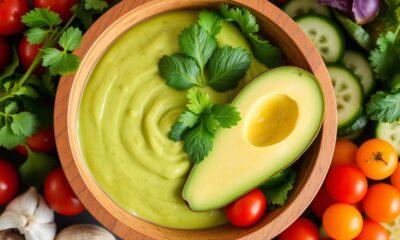
 Keto Friendly Ingredients2 weeks ago
Keto Friendly Ingredients2 weeks agoBest Salad Dressing for Keto Diet
-

 Keto Friendly Ingredients1 month ago
Keto Friendly Ingredients1 month agoEggs: A Keto Diet Powerhouse






